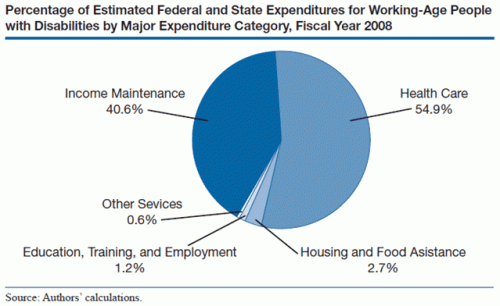There are around 19 million disabled persons between the ages of 18 and 64 in the U.S. (6.4% of all persons in this age range), and the federal government and states spent around $425 billion on assistance to them in 2008 according to a new paper in Health Affairs.* This paper focuses on the proportion of this assistance that goes for health care as compared to the other aid components. Health care costs for this group are increasing rapidly, while spending on education, training and employment is declining.
Around half of the disabled working age adults in the U.S. have their health care costs paid for by three programs: the Veterans Administration, Medicare and Medicaid (some are dual eligibles, covered by Medicare and Medicaid due to their disability/poverty status). Health care expenditures were both the largest and fastest growing component of assistance provided to working age disabled persons from 2002 to 2008. A limitation noted by the authors is their inability to provide per capita expenditures for persons by program, eligibility for multiple programs, and reason for disability. This would be especially useful for the dual-eligible patients. Such persons are a part of the roughly 6 million persons nationally who are eligible for Medicare and Medicaid who are not age 65 or over and are a part of what I call “the third Medicaid program (with low income non disabled persons being program 1, and elderly dual eligibles being program 2).
This “third program” in Medicaid–non elderly dual eligibles is the most diverse portion of the Medicaid population due to the many reasons for their disability. More clarity on the reasons for the qualifying disability could be useful to identify strategies to address patient needs in the most efficient means possible, as well as to inform any potential reform strategies for how to best care for such persons.
The need to better understand the needs of these groups is heightened by the looming expansion of Medicaid as part of the Affordable Care Act. Expanded access to Medicaid under the ACA will likely serve to increase the differential eligibility (lag between Medicaid eligibility and Social Security and Medicare disability) for the variety of programs for which disabled working age adults may be eligible. There are likely issues of duplication and of unmet need, and certainly of timing. Similarly, persons with disabilities that prevent them from working but who are now ineligible for programs due to the degree of their disability will presumably be added to the ranks of the insured via income based subsidies (if incomes are above 133% of poverty).
Care coordination issues abound for disabled persons of working age and these issues require more attention.
*Gina Livermore, David C. Stapleton, Meghan O’Toole. Health Care Costs Are a Key Driver of Growth in Federal And State Assistance to Working-Age People with Disabilities. Health Affairs 2011;30:9:1664-72.
update: added the link to the paper


